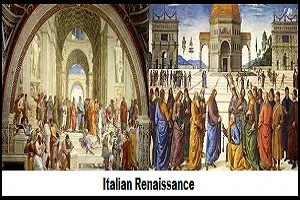The Italian Renaissance, spanning roughly from the 14th to the 17th century, stands as one of the most influential periods in Western history. It was a time of significant cultural, artistic, and intellectual rebirth, characterized by a revival of interest in the classical world of Greece and Rome. The Renaissance originated in Italy, particularly in Florence, and then spread across Europe, leaving an indelible mark on various fields such as art, literature, philosophy, science, and politics.
Origins and Influences
The Italian Renaissance emerged from a combination of factors. The decline of feudalism and the Black Death pandemic led to the weakening of traditional social structures, fostering an environment ripe for change. Additionally, the fall of the Byzantine Empire in 1453 brought a flood of Greek scholars and texts to Italy, sparking a renewed interest in classical learning.
Artistic Achievements
Art flourished during the Renaissance, with renowned artists such as Leonardo da Vinci, Michelangelo Buonarroti, and Raphael producing masterpieces that still captivate audiences today. The period witnessed a shift from the stylized forms of medieval art to more realistic portrayals of the human figure. Techniques such as linear perspective and chiaroscuro were developed, adding depth and realism to paintings. Notable works include Leonardo's "Mona Lisa," Michelangelo's "David," and Raphael's "The School of Athens."
Literary Contributions
Italian literature experienced a golden age during the Renaissance, marked by the works of poets and writers like Dante Alighieri, Petrarch, and Giovanni Boccaccio. Dante's "Divine Comedy," Petrarch's sonnets, and Boccaccio's "Decameron" are enduring classics that exemplify the era's literary brilliance. These writers drew inspiration from classical texts while also contributing to the development of the Italian vernacular, laying the foundation for modern Italian literature.
Scientific Advancements
The Renaissance saw significant advancements in science and mathematics, driven by individuals such as Galileo Galilei, Nicolaus Copernicus, and Leonardo da Vinci. Galileo's observations with the telescope revolutionized our understanding of the universe, while Copernicus proposed a heliocentric model of the solar system, challenging the geocentric view inherited from antiquity. Leonardo's scientific curiosity encompassed anatomy, engineering, and botany, as evidenced by his detailed anatomical sketches and designs for flying machines.
Humanism and Education
Central to the Renaissance was the humanist movement, which emphasized the study of classical texts and the potential of human achievement. Humanist scholars like Giovanni Pico della Mirandola and Marsilio Ficino promoted the idea of human dignity, individualism, and the pursuit of knowledge for its own sake. This intellectual curiosity led to the establishment of universities and the proliferation of education, laying the groundwork for the modern education system.
Legacy and Impact
The Italian Renaissance had a profound and lasting impact on Western civilization. Its emphasis on humanism, innovation, and artistic expression laid the groundwork for the Enlightenment and the Scientific Revolution. The period also transformed Italy into a cultural powerhouse, with cities like Florence, Rome, and Venice becoming centers of artistic and intellectual activity. The legacy of the Renaissance continues to shape our understanding of art, literature, science, and the human experience, making it a defining epoch in history.
Facts about the Italian Renaissance
Here are some facts about the Italian Renaissance,among others:
1. Timeframe
The Italian Renaissance spanned roughly from the 14th to the 17th century, marking a period of significant cultural, artistic, and intellectual rebirth.
2. Birthplace
It originated in Italy, particularly in cities like Florence, Rome, and Venice, before spreading across Europe.
3. Humanism
Humanist ideals, emphasizing the potential of human achievement and the study of classical texts, were central to the Renaissance.
4. Artistic Mastery
The Renaissance produced iconic artworks by renowned artists such as Leonardo da Vinci, Michelangelo Buonarroti, and Raphael, known for their realism and depth.
5. Literary Brilliance
Italian literature flourished with the works of Dante Alighieri, Petrarch, and Giovanni Boccaccio, contributing to the development of the Italian vernacular.
6. Scientific Progress
Renaissance thinkers like Galileo Galilei and Nicolaus Copernicus made groundbreaking discoveries in astronomy and physics, challenging traditional views of the cosmos.
7. Architectural Innovations
The era witnessed the revival of classical architectural styles, with notable examples including Florence's Duomo and Rome's St. Peter's Basilica.
8. Legacy
The Italian Renaissance's legacy continues to influence art, literature, science, and philosophy, shaping modern Western civilization.
In conclusion, the Italian Renaissance represents a remarkable period of cultural, artistic, and intellectual achievement. It was a time of innovation and discovery that forever changed the course of Western civilization, leaving behind a rich legacy that continues to inspire and influence generations to this day.
That is the article entitled The Italian Renaissance: A Flourishing Epoch of Art, Literature, and Learning. If there are any deficiencies or errors in writing this article, the Pustaka Pengetahuan expresses its deepest apologies. Please leave a wise message in the comments column provided. Thank you for visiting, hopefully it's useful.
Other reading materials, can help with school assignments, click Berbagai Reviews
To increase insight and knowledge, please click Baraja Farm
For tutorial on how to cultivate, please click Baraja Farm Channel
Social media please click facebook

Tidak ada komentar:
Posting Komentar